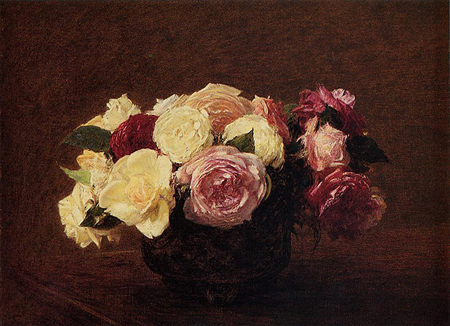
Dutch tulips, French lilies and Japanese cherry blossom feature among the Observer art critic's selection.
Dutch tulips, French lilies and Japanese cherry blossom feature among the Observer art critic's selection.
1. Judith Leyster
Tulip from Her Tulip Book (1643)Frans Hals Museum, Haarlem

When the Dutch artist Judith Leyster painted this striped specimen in 1643, pictures of tulips were regarded as cheap substitutes for the real thing because the bulbs had become prodigiously expensive. Tulip books became wildly popular too. Even Leyster, more celebrated for her droll and uplifting portraits, produced one for the burgeoning market. Some were upscale catalogues promoting different varieties – this is a Brabanson – but hers seems to have been made for pure visual pleasure. This graceful tulip is now in the Frans Hals Museum, which is annoying because Hals stole one of Leyster’s best pupils
2. Monet
Blue Water Lilies (1916-1919)Musée d’Orsay, Paris

Monet, in old age, said he took more pride in his garden than his art and, in particular, the pond of waterlilies he grew at Giverny. These large white flowers, with their broad, waxy surfaces, tend to hold and reflect the changing light of the day. Here, it feels like late afternoon and the field of vision appears limitless and blue. The painting effects dissolves between surface and depth, between near and far, between the water and the lilies. Close up, the flowers disappear in the nearly illegible brushstrokes; far away, they resemble evening stars
3. Georgia O’keeffe
Oriental Poppies (1928)Weisman Art Museum, Minneapolis

“If I could paint the flower exactly as I see it no one would see what I see because I would paint it small like the flower is small. So I said to myself – I’ll paint it big… and they will be surprised.” O’Keeffe’s poppies are among her most famous works, the glossy red and orange flowers exploding on a canvas almost four feet wide. There is no background to distract from their sheer force of personality. Made in 1928, the painting is a vast close-up, pulling the eye into the dark heart of these flowers through the power of scale and colour
4. Manet
Lilacs in a Vase (c 1882)
Nationalgalerie, Berlin

During his long final illness, Manet began to paint beautifully aphoristic pictures of flowers in crystal vases. His subjects were the posies friends brought to his Paris sickroom, in this case white lilac. Fascinated by the stems refracted through the silvery water, and by the flocculent green-in-white blossoms, he paints something closer to a portrait than a still life. You can feel the thick darkness – the darkness of late Goya, whom Manet admired from first to last – closing in around these lightsome white heads on their fragile stems. Flowers with the status of people
5. Andy Warhol
Flowers (1970)The Andy Warhol Museum, Pittsburgh

Warhol often turned to flowers for inspiration, from the blotted-line daisies of the 1950s to the Japanese ikebana prints of the 70s. But his most famous series of flower paintings, begun in 1964, was based on a photograph of hibiscus blossoms (the photographer attempted to sue). He would drench the flower’s floppy shape with brilliant colour and set a quartet of blossoms against a background of undergrowth. They came in multiple colour schemes for the next 20 years, more or less detailed or abstracted: floating flowers transformed into psychedelic decor
6. Hokusai
Bullfinch on Weeping Cherry (c 1840)British Library, London

Which way up? Hokusai’s marvellous image of spring cherry blossom with blue sky behind it is frequently reproduced upside down. You can see why: the pink and white flowers blossom in space, there is no sense of gravity and the bullfinch doesn’t help with orientation. There is a giddy sense of floating among the bright petals, and no middle distance, so that the eye travels all over the image. And though we speak of flatness and abstraction in Japanese prints, in this case the picture has it right: our eyes really do get lost in the floating world of cherry blossom
7. Dürer
Tuft of Cowslips (1526)National Gallery of Art, Washington DC

Dürer’s art is all about pointing things out, defining their likeness, making them visible and with as much accuracy as possible. A chunk of turf, a quivering harebell, a tuft of cowslips: his drawings are superb and always botanically exact. But notice how he depicts this little clump of spring flowers, leaves, roots and all, like a floating island on the page. A vignette in space, out of context, the cowslips look newly wondrous and strange, despite their basis in observable truth. This is Primula veris, blossoming from April onwards in Germany
8. Jan Brueghel
Flowers in a Vase (year unknown)National Museum of Art, Bucharest

Lilies, tulips, fritillaries, daffodils, snowdrops, carnations, cornflowers, peonies, anemones, roses: this is an all-together-now bouquet and one of the largest and most luscious in art. But is it real? Could all these flowers have blossomed at the same time in 17th-century Holland without hothouses and chemical sprays? Possibly, but this is a vanitas painting, combining the real, the ideal and the symbolic. It would have given its wealthy patron a garden of flowers in a single vase, but it reminds him of his death as well. Some of the flowers are beginning to fade, others have already fallen
9. Henri Fanti-Latour
Roses (1894)Private collection

Fantin-Latour is the great rose man. He painted roses from first to last, never tiring of their beauty. There is even a shrub rose named after him and it is (I think) right there at the centre of this bowl full of heavy, drowsy, scented blooms, in many shapes, colours and petal forms. Fantin-Latour is praised in Proust and sold almost every work as soon as it was finished, mainly to the English. This is a painting of summer roses that is for once as ravishing as the real thing
10. Van Gogh
Vase with Pink Roses (1890)National Gallery of Art, Washington DC

Theo Guardian





